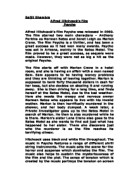In the film A Single Man directed by Tom Ford, film techniques were used to help us understand the main character, George Falconer (Colin Firth) and the transformation on his outlook of life, allowing us to sympathise/empathise with him along his journey.
Film Essay
A journey through one’s life and the many discoveries made along are extremely significant. It can influence another’s life or provide them with a powerful message. In the film A Single Man directed by Tom Ford, film techniques were used to help us understand the main character, George Falconer (Colin Firth) and the transformation on his outlook of life, allowing us to sympathise/empathise with him along his journey. These cinematic techniques include cinematography, saturation, and soundtrack. Set in Los Angeles, California 1962 shortly after the Cuban Missile Crisis, the film is based on Christopher Isherwood’s novel of the same name, and is depicted around one day in the life of George, as he contemplates suicide after the death of his partner of sixteen years, Jim (Matthew Goode) which occurred eight months ago.
Cinematography plays a huge role in A Single Man, as it assists us in understanding George. The framing in the film helps draw our attention to certain characters, emphasising their actions and emotions. It has been effectively used to show George being disconnected from the world. In the flashback to George receiving a phone call informing him of Jim’s death and his rejection to the funeral, a medium close-up is used to potray him alone in his chair. His emotional response is expressed while intimacy is provided. No music played, allowing us to focus on George spiraling into a freefall of emotion. The effect of cropping his head from the image allows intensity to occur within the atmosphere of the scene. A sense of claustrophobia is given, showing isolation due to grief as he is trapped in the world on his own. This makes us understand his situation, and sympathise for the increasing despair he must feel in his life. George’s sense of isolation is further heightened by the visual technique of camera angles. Whilst lecturing at the university, a high angle shot is used and George is framed in the centre of the screen amidst a crowd of students with faceless shadows, who are all moving in the opposite direction. From this angle, George appears isolated from others. This supports the idea of George being isolated from society as a result of his desired sexual orientation. A strong impression is therefore made of his noticable difference and his cold sense of despair that overtook him, from a seemlingly ‘perfect’ society and their jusgemental norms. Through the use of cinematography, we can identify with his rejection from society and absolute despair, to his transfiguration as he gradually starts to gain hope through the connections made in his spiritual journey. It provides us with a message, to never give up hope in life.








